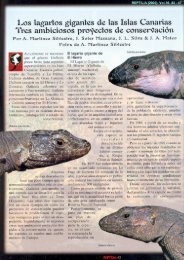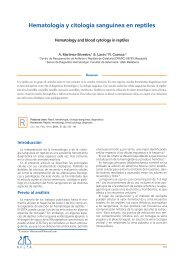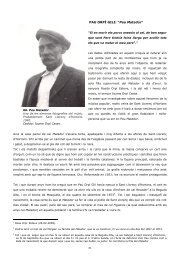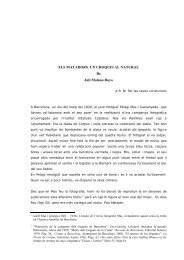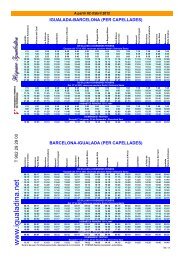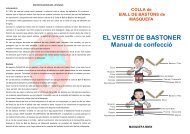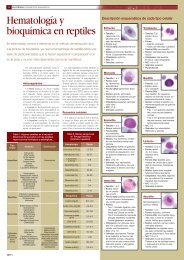Massive Tachygonetria (Oxyuridae) infection in a ... - aMasquefa
Massive Tachygonetria (Oxyuridae) infection in a ... - aMasquefa
Massive Tachygonetria (Oxyuridae) infection in a ... - aMasquefa
Create successful ePaper yourself
Turn your PDF publications into a flip-book with our unique Google optimized e-Paper software.
CLINICAL CASE<br />
<strong>Massive</strong> <strong>Tachygonetria</strong> (<strong>Oxyuridae</strong>)<br />
<strong><strong>in</strong>fection</strong> <strong>in</strong> a Herman’s tortoise<br />
(Testudo hermanni)<br />
Albert Mart<strong>in</strong>ez-<br />
Silvestre<br />
DVM, MSc, Dipl. ECZM<br />
(herpetology)<br />
C.R.A.R.C<br />
Catalonian Reptile<br />
and Amphibian<br />
Rehabilitation Centre<br />
08783 Masquefa,<br />
Barcelona<br />
SpA<strong>in</strong><br />
PRESENTATION<br />
The massive parasitation by <strong>Tachygonetria</strong><br />
<strong>Oxyuridae</strong> parasites <strong>in</strong> a 15-year-old male<br />
Mediterranean or Herman’s tortoise (Testudo<br />
hermanni hermanni), weigh<strong>in</strong>g 560 g, is<br />
presented. The effectiveness of common<br />
treatment with fenbendazole is also discussed.<br />
HISTORY<br />
A male Herman’s tortoise (Testudo hermanni<br />
hermanni), from a rescue centre on Majorca<br />
Island (Spa<strong>in</strong>), was referred to the CRARC<br />
(Catalonian Reptile and Amphibian Rehabilitation<br />
Centre (Barcelona, Spa<strong>in</strong>)) for evaluation of<br />
anorexia of 2-month duration. The tortoise<br />
belonged to a group of tortoises that were to be<br />
released <strong>in</strong>to the Montsant Natural Park<br />
(Catalonia, Spa<strong>in</strong>). At the time of cl<strong>in</strong>ical<br />
exam<strong>in</strong>ation, the tortoise had numerous little<br />
parasites around its cloaca. The tortoise ate a<br />
variety of vegetables and fruit <strong>in</strong> an outdoor<br />
facility with access to direct sunlight, subject to<br />
the natural temperature fluctuations of the area.<br />
The tortoise hibernated <strong>in</strong> w<strong>in</strong>ter, from October<br />
to March.<br />
CLINICAL FINDINGS<br />
Upon cl<strong>in</strong>ical exam<strong>in</strong>ation, the tortoise was alert<br />
and awake but it had low weight, and was<br />
dehydrated and cachectic. The eyes were sunken <strong>in</strong><br />
the orbits and the oral mucosa was pale. The limb<br />
movements were dim<strong>in</strong>ished. The parasites were<br />
whitish, measur<strong>in</strong>g about 5 mm <strong>in</strong> length, and<br />
formed groups of hundreds that occupied the entire<br />
tail, which were observed macroscopically <strong>in</strong><br />
outly<strong>in</strong>g areas of the cloaca (Figures 1 and 2).<br />
DIAGNOSTIC TESTS<br />
All parasites were removed from the cloaca and<br />
adjacent areas (shell and legs) for microscopic<br />
analysis with a stereo magnifyng glass. Ten<br />
parasites were measured, photographed, and<br />
preserved <strong>in</strong> alcohol <strong>in</strong> the CRARC private<br />
collection. The length of the collected worms<br />
varied from 3.8 to 5.2 mm. The parasite was<br />
classified on the basis of previously published<br />
keys (Gagno, 2006) as Nematelm<strong>in</strong>t roundworms,<br />
Oxuyroidae family, <strong>Tachygonetria</strong> conica species<br />
(Drasche, 1884) (Figures 3 and 4), which are<br />
common gastro<strong>in</strong>test<strong>in</strong>al parasites <strong>in</strong> Testudo<br />
hermanni from Spa<strong>in</strong>, France, and Italy.<br />
Figure 1.<br />
CONSULT Journal, Special 2011, Pages 409-412.<br />
consulta • 409
CLINICAL CASE<br />
Figure 2.<br />
Figure 3.<br />
Figure 4. Figure 5.<br />
TablE I<br />
Haematology and biochemical data pre and post fenbendazole treatment,<br />
<strong>in</strong> comparison with reference data for Testudo hermanni (Mathes et al., 2005) (Mar<strong>in</strong> et al., 2001).<br />
Haematology Results (pre-treatment) Results (post-treatment) Range<br />
Haematocrit (%) 32 32 16–35<br />
Red blood cells (x 10 12 /L) 0.8 0.79 0.7–1.2<br />
White blood cells (x 10 9 /L) 4.2 4.8 1.2–7.13<br />
Heterophils (%) 45 56 32–50<br />
Eos<strong>in</strong>ophils (%) 12 2 2–8<br />
Basophils (%) 0 0 0–2<br />
Monocytes (%) 0 0 0–4<br />
Lymphocytes (%) 33 42 12–48<br />
biochemistry Results (pre- treatment) Results (post-treatment) Range<br />
Total prote<strong>in</strong> (g/L) 41 43 39–54<br />
Glucose (mmol/L) 2.50 3.61 2.94–5.94<br />
Uric acid (umol/L) 333.09 309.30 124.91–576.96<br />
AST (IU/L) 65 43 9–103<br />
Potassium (mmol/L) 4.80 4.00 3.59–6.90<br />
Sodium (mmol/L) 135 128 117–137<br />
Chloride (mmol/L) 28.36 29.47 26.69–31.97<br />
410 • consulta
One-cm fresh faeces were also sampled for<br />
coprological study. Coprological analysis was<br />
performed by sedimentation (or the Telemann<br />
method) us<strong>in</strong>g 4% formal<strong>in</strong> solution and ethyl<br />
acetate as ma<strong>in</strong> reagents. Us<strong>in</strong>g this technique, it<br />
was confirmed that all eggs were of the<br />
previously identified species (Figure 5).<br />
A blood sample was obta<strong>in</strong>ed by puncture of the<br />
dorsal coccigeal ve<strong>in</strong> before and after treatment<br />
with antiparasitic fenbendazole (Table I).<br />
TREATMENT<br />
Therapy was started by us<strong>in</strong>g fenbendazole<br />
(Panacur, Intervet) at a s<strong>in</strong>gle dose of 50 mg/kg<br />
per day for 4 days, repeat<strong>in</strong>g this dos<strong>in</strong>g regime<br />
two weeks later. Fluids were also adm<strong>in</strong>istered at<br />
a rate of 50% R<strong>in</strong>ger Lactate with 5% Dextrose,<br />
as well as by force-feed<strong>in</strong>g by an<br />
oesophagostomy feed<strong>in</strong>g tube (Figure 6).<br />
Nutritional complexes rich <strong>in</strong> prote<strong>in</strong>s, vitam<strong>in</strong>s,<br />
and trace elements were adm<strong>in</strong>istered by tube<br />
feed<strong>in</strong>g (Gevral Prote<strong>in</strong>a (Wyeth Farma, S.A.)).<br />
Figure 6.<br />
OUTCOME<br />
The tortoise began to eat by itself after 20 days.<br />
The feed<strong>in</strong>g tube was removed two days later. It<br />
began to improve <strong>in</strong> weight and 1 month after<br />
admission the turtle weighed 680 g. Coprological<br />
analysis was repeated 7 days after tube removal<br />
and the faeces were free of parasites. The oral<br />
mucosa had a p<strong>in</strong>kish and healthy colour. After 4<br />
months, the tortoise was marked and released <strong>in</strong><br />
Montsant Natural Park (Catalonia, Spa<strong>in</strong>).<br />
DISCUSSION<br />
Control of p<strong>in</strong>worm numbers is important <strong>in</strong> freeliv<strong>in</strong>g<br />
reptiles. These parasites can cause<br />
malabsorption or <strong>in</strong>test<strong>in</strong>al problems (Jacobson,<br />
2007). In addition, they can cause tisular migration<br />
and visceral <strong>in</strong>flammatory lesions. This has been<br />
described for the Trachemys scripta turtle, <strong>in</strong> which<br />
pancreatitis was observed due to helm<strong>in</strong>th tissue<br />
migration (Hidalgo et al., 2010).<br />
The Telemann method is a parasite detection<br />
technique by centrifugation and isolation of<br />
parasites us<strong>in</strong>g the phase separation of two<br />
immiscible liquids such as formaldehyde and<br />
ethyl acetate (Thienport et al., 1986).<br />
This method provides a higher egg recovery rate, as<br />
well as a decrease <strong>in</strong> the false negative results<br />
commonly seen <strong>in</strong> flotation techniques used <strong>in</strong> pet<br />
cl<strong>in</strong>ics. The method is not commonly used <strong>in</strong> exotic<br />
pet cl<strong>in</strong>ics but, <strong>in</strong> view of the high number of<br />
parasites <strong>in</strong> reptiles (Jacobson, 2007), it could be a<br />
more widely used method with a view to enhanc<strong>in</strong>g<br />
egg detection <strong>in</strong> tortoise stool (Cray & Zaias, 2004).<br />
Nematodes are common <strong>in</strong> the digestive system<br />
of tortoises and especially <strong>in</strong> Hermann tortoises<br />
(Testudo hermanni) (Gagno, 2006). Nematode<br />
overload is commonly encountered <strong>in</strong> reptiles<br />
housed <strong>in</strong> poor conditions, and has also been<br />
associated with disease and mortality <strong>in</strong> captive<br />
iguanas (Loukopoulos et al., 2007), tortoises<br />
(Rideout et al., 1987), and snakes (Lichtenfels &<br />
Lavies, 1976).<br />
Oxyurids such as the <strong>Tachygonetria</strong> genus are<br />
common <strong>in</strong> the colon of tortoises, although they<br />
are usually non-pathogenic. However, impaction<br />
due to oxyurid <strong><strong>in</strong>fection</strong> has been reported <strong>in</strong> a<br />
Fiji Island iguana (Kane et al., 1976) and <strong>in</strong> a<br />
common iguana <strong>in</strong> Japan (Munakata, 1999) and<br />
Greece (Loukopoulos et al., 2007). In all these<br />
cases, a large number of parasites were found<br />
dur<strong>in</strong>g necropsy <strong>in</strong> stomach, <strong>in</strong>test<strong>in</strong>e, and colon.<br />
Cl<strong>in</strong>ical signs of anorexia, regurgitation,<br />
obstruction, and abdom<strong>in</strong>al distension have been<br />
attributed to the presence of such parasites <strong>in</strong><br />
these cases. Abdom<strong>in</strong>al distension is an<br />
undetectable sign <strong>in</strong> tortoises due to the<br />
presence of the shell. Although anorexia and<br />
starvation were observed <strong>in</strong> the present case,<br />
they are a common signs of diseases and not<br />
specific to parasites.<br />
Occupants of the <strong>in</strong>test<strong>in</strong>al lumen such as<br />
p<strong>in</strong>worms (<strong>Oxyuridae</strong>) deprive the host of<br />
important nutrients. In young reptiles, growth<br />
disturbances may be seen, and the fertility rate <strong>in</strong><br />
females drops (Schneller & Pantchev, 2008).<br />
Nematodes can cause severe digestive<br />
agglomerations that compromise the <strong>in</strong>test<strong>in</strong>al<br />
function and can cause chronic weight loss,<br />
impaction, and even death <strong>in</strong> herbivorous reptiles<br />
(Loukopoulos et al., 2007). .<br />
Currently, Herman’s tortoise is considered<br />
endangered <strong>in</strong> Spa<strong>in</strong> and, consequently, many<br />
are released <strong>in</strong> the wild (Martínez Silvestre, 1999;<br />
Soler Massana et al., 2001). In nature, released<br />
tortoises will f<strong>in</strong>d other tortoises with the same<br />
parasites (Asakawa et al., 2001; Gagno, 2001).<br />
As a result, deworm<strong>in</strong>g should not aim to<br />
completely elim<strong>in</strong>ate the Oxyura parasites<br />
(Gagno, 2007). Only <strong>in</strong> critical cases is full and<br />
deep deparasitation necessary.<br />
CLINICAL CASE<br />
consulta • 411
CLINICAL CASE<br />
Although most oxyurid <strong><strong>in</strong>fection</strong>s pose no cl<strong>in</strong>ical<br />
problem for tortoises, <strong><strong>in</strong>fection</strong> with<br />
Tachygometria sp. result<strong>in</strong>g <strong>in</strong> disease has been<br />
reported <strong>in</strong> a Hermann’s tortoise. Treatment of<br />
tortoises for nematodiasis is challeng<strong>in</strong>g because<br />
of the difficulty of access<strong>in</strong>g the oral cavity,<br />
toxicosis associated with the anthelm<strong>in</strong>tic<br />
ivermect<strong>in</strong> (Fitzgerald, 2008; Kl<strong>in</strong>gerberg, 1992),<br />
and prolonged gastro<strong>in</strong>test<strong>in</strong>al transit time,<br />
which can affect drug absorption.<br />
Fenbendazole is the drug of choice for treat<strong>in</strong>g<br />
nematode <strong><strong>in</strong>fection</strong>s <strong>in</strong> reptiles. It can be<br />
adm<strong>in</strong>istered percloacally as a liquid, or the<br />
powdered form can be placed on food. In<br />
cont<strong>in</strong>ued treatment, the liquid form can be<br />
given by the gastric catheter used <strong>in</strong> forced<br />
feed<strong>in</strong>g.<br />
Fenbendazole is a benzimidazole drug used to<br />
treat many reptile parasites, ma<strong>in</strong>ly <strong>in</strong>volv<strong>in</strong>g<br />
p<strong>in</strong>worms (<strong>Oxyuridae</strong>) and ascaris,<br />
acanthocephalan, Heterakis, Spiruridae,<br />
Trichuridae, Cosmocercoides, Strongyloides,<br />
Pentastomida and liver flukes (Dicrocoelium and<br />
Fasciola). All of these parasites are frequent <strong>in</strong> an<br />
exotic animals cl<strong>in</strong>ic, so fenbendazole use on<br />
reptiles is very common, especially <strong>in</strong> land<br />
tortoises (Gre<strong>in</strong>er & Schumacher, 1998).<br />
Benzimidazoles act by <strong>in</strong>hibit<strong>in</strong>g tubul<strong>in</strong><br />
polymerization, which affects the formation of<br />
microtubules, movement of <strong>in</strong>tracellular particles,<br />
cell mitosis and structure, and exocytosis. Loss of<br />
microtubules from the tegument and <strong>in</strong>test<strong>in</strong>al<br />
cells of nematodes leads to their starvation and<br />
<strong>in</strong>hibition of egg production.<br />
Benzimidazole aff<strong>in</strong>ity is high for parasites but this<br />
drug has also been described as dangerous for<br />
vertebrates. In Herman’s tortoises, fenbendazole<br />
has been described as possibly caus<strong>in</strong>g<br />
heteropenia, leucopenia, and generalized<br />
lymphopenia, as well as <strong>in</strong>creases <strong>in</strong> uric acid,<br />
phosphorus, and total prote<strong>in</strong>s or decreased<br />
glucose <strong>in</strong> <strong>in</strong>tensive treatment regimes as <strong>in</strong> the<br />
present case (Neiffer et al., 2005). Accord<strong>in</strong>gly, the<br />
risk of mortality of an <strong>in</strong>dividual from nematode<br />
<strong><strong>in</strong>fection</strong> should be assessed relative to the<br />
potential for metabolic alteration and secondary<br />
septicemia follow<strong>in</strong>g damage to haematopoietic<br />
and gastro<strong>in</strong>test<strong>in</strong>al systems by fenbendazole.<br />
In the present case, the use of fenbendazole is<br />
<strong>in</strong>dicated <strong>in</strong> comb<strong>in</strong>ation with blood control and<br />
health status evolution of the animal. The good<br />
results <strong>in</strong> blood tests and recovery of weight and<br />
appetite after treatment allowed a favourable<br />
prognosis of the case. Changes <strong>in</strong> glucose and<br />
eos<strong>in</strong>ophils can be expla<strong>in</strong>ed by improved health<br />
status to parasitism and not by a fenbendazole<br />
secondary effect.<br />
The use of oesophagostomy feed<strong>in</strong>g tubes <strong>in</strong><br />
tortoises should not be restricted to term<strong>in</strong>al<br />
cases of anorexia, but could also be used <strong>in</strong><br />
therapies that need various products and drugs<br />
by forced feed<strong>in</strong>g daily for a few weeks.<br />
Acknowledgements<br />
S<strong>in</strong>cere thanks are expressed to Joaquim Soler,<br />
Jose Antonio Mateo, and Lluis Parpal, as well as<br />
to the Monsant Natural Park, the Balearic Islands<br />
Government, and the Wildlife Rescue Centre of<br />
Majorca Island.<br />
REFERENCES<br />
Alvarado,T.P., Garner,M., Gamble,K., Levens,G.P., Raymond,J.T.,<br />
Nordhausen,R., 2001. Fenbendazole overdose <strong>in</strong> four fea's vipers<br />
(Azemiops feae). Proceed<strong>in</strong>gs of the ARAV 8:35-36.<br />
Asakawa,M., Suzuki,Y., Kimoto,Y., Fox,M.T., 2001. Parasitic<br />
nematodes of pet tortoises <strong>in</strong> Japan: cl<strong>in</strong>ical and ecological view<br />
po<strong>in</strong>ts. Proceed<strong>in</strong>gs of the ARAV 8:139-144.<br />
Cray,C., Zaias,J., 2004. Laboratory procedures. Veter<strong>in</strong>ary Cl<strong>in</strong>ics of<br />
North America: Exotic Animal Practice 7:518.<br />
Fitzgerald,K.T., 2008. MASTER CLASS: POISONINGS IN CAPTIVE<br />
REPTILES. Proceed<strong>in</strong>gs Association of Reptilian and Amphibian<br />
veter<strong>in</strong>arians 15:113-115.<br />
Gagno,S., 2001. Preparation aux re<strong>in</strong>troductions de Testudo hermanni<br />
hermanni: controle parasitologique <strong>in</strong>test<strong>in</strong>al-premiers resultats.<br />
Proceed<strong>in</strong>gs of the International Congress on Testudo Genus 3:157-160.<br />
Gagno,S., 2006. Parasitologie des cheloniens helm<strong>in</strong>thes: biologie ,<br />
ecologie, pathologie. 1 edition. Volume 5. Editions SOPTOM.<br />
Gagno,S., 2007. Impact de la faune helm<strong>in</strong>thique <strong>in</strong>test<strong>in</strong>ale de<br />
Testudo hermanni (Gmel<strong>in</strong>, 1789) (Chelonii, Testud<strong>in</strong>idae). Congress<br />
Mediterraneen d'Herpetologie 1:52-53.<br />
Gre<strong>in</strong>er,E.C., Schumacher,J. 1998. Parasitology. Pages 689-702 <strong>in</strong><br />
Ackerman, L. editor. The biology, husbandry and health care of<br />
reptiles. TFH, New Jersey.<br />
Gre<strong>in</strong>er,E.C., Schumacher,J. 1998. Parasitology. Pages 689-702 <strong>in</strong><br />
Ackerman,L. editor. The biology, husbandry and health care of<br />
reptiles. TFH, New Jersey.<br />
Hidalgo-Vila, J., Martínez-Silvestre, A., Ribas, A., Casanova, J.C.,<br />
Pérez-Santigosa, N., Díaz-Paniagua, C. (2011) Pancreatitis associated<br />
with helm<strong>in</strong>th Serp<strong>in</strong>ema microcephalus (Nematoda: Camallanidae)<br />
<strong>in</strong> exotic red-eared slider turtles (Trachemys scripta elegans). Journal<br />
of Wildlife Diseases, 47:201-205.<br />
Jacobson,E.R. 2007. Parasites and parasitic diseases of reptiles. Pages<br />
571-666 <strong>in</strong> Jacobson,E.R. editor. Infectious Diseases and Pathology<br />
of Reptiles: Color Atlas and Text. CRC Press, Boca Raton, Florida.<br />
Kane, K. K., R. M. Corw<strong>in</strong>, and W. J. Boever. 1976. Impaction due to<br />
Oxyurid <strong><strong>in</strong>fection</strong> <strong>in</strong> a Fiji Island iguana (a case report). Vet. Med.<br />
Small Anim. Cl<strong>in</strong>. 71: 183–184.<br />
Kl<strong>in</strong>gerberg,R.J., 1992. A comparison of Fenbendazole and ivermect<strong>in</strong><br />
for the treatment of nematode parasites <strong>in</strong> Ball pythons, Python<br />
regius. Bullet<strong>in</strong> of the Assotiation of Reptilian and Amphibian<br />
Veter<strong>in</strong>arians 2(2):5-6.<br />
Lichtenfels, J. R., and B. Lavies. 1976. Mortality <strong>in</strong> red-sided garter<br />
snakes, Thamnophis sirtalis parietalis, due to larval nematode,<br />
Eustrongylides sp. Lab. Anim. Sci. 26: 465–467.<br />
Loukopoulos,P., Komnenou,A., Papadopoulos,E., Psychas,B., 2007. Lethal<br />
ozolaimus megatyphlon <strong><strong>in</strong>fection</strong> <strong>in</strong> a green iguana (Iguana iguana<br />
rh<strong>in</strong>olopa). Journal of Zoo and Wildlife Medic<strong>in</strong>e 38:131-134.<br />
Mar<strong>in</strong>,A., Bertolero,A., Aguiló,M., Conesa,D., 2001. Haematological<br />
parameters <strong>in</strong> the hermann's tortoise Testudo hermanni hermanni<br />
and their application to conservation projects. Proceed<strong>in</strong>gs of the<br />
International Congress on Testudo Genus 3:346-348.<br />
Martínez Silvestre,A., 1999. Libération de tortues en Espagne. La<br />
Tortue 48:34-35.<br />
Mathes,K., Holz,A., Fehr,M., 2005. blood reference values of four<br />
species of terrestrial tortoises (Testudo spp.) <strong>in</strong> germany. Proceed<strong>in</strong>gs<br />
Association of Reptilian and Amphibian veter<strong>in</strong>arians 12:55-59.<br />
Munakata, Y., I. Inoue, and A. Shirai. 1999. Ozolaimus megatyphlon<br />
(Nematoda: Pharyngodonidae) isolated from a green iguana (Iguana<br />
iguana rh<strong>in</strong>olopa). J. Jpn. Vet. Med. Assoc. 52: 784–787.<br />
Neiffer,D.L., Lydick,D., Burks,K., Doherty,D., 2005. Hematologic and<br />
plasma biochemical changes associated with Fenbendazole<br />
adm<strong>in</strong>istration <strong>in</strong> Hermann's tortoises (Testudo hermanni). Journal of<br />
Zoo and Wildlife Medic<strong>in</strong>e 36:661-672.<br />
Rideout, B. A., R. J. Montali, L. G. Phillips, and C. H. Gard<strong>in</strong>er. 1987.<br />
Mortality of captive tortoises due to viviparous nematodes of the genus<br />
Proatractis (Family Atractidae). J. Wildl. Dis. 23: 103–108.<br />
Soler Massana,J., Martínez Silvestre,A., Tar<strong>in</strong>,R., Parellada,X., 2001.<br />
Premiers resultats de la re<strong>in</strong>troduction de la Tortue d'Hermann<br />
(Testudo hermanni hermanni) dans le massif du Garraf (Catalogne,<br />
Espagne). Proceed<strong>in</strong>gs of the International Congress on Testudo<br />
Genus 3:230-232.<br />
Thienport, D., Rochette,F.,Vanparjis, O.F.J. (1986): Diagnos<strong>in</strong>g<br />
helm<strong>in</strong>thiasis by coprological exam<strong>in</strong>ation. Janssen Research<br />
Foundation. Beerse, belgium. 205 pp.<br />
412 • consulta





